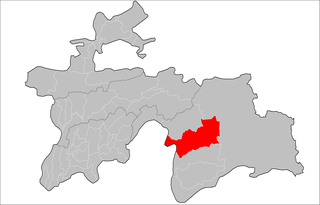Rushon District
|
Rushon District Ноҳияи Рӯшон |
|
|---|---|
| District | |
| Ноҳияи Рӯшон | |
 Location of Rushon District in Tajikistan |
|
| Country |
|
| Province | Gorno-Badakhshan Autonomous Region |
| Capital | Rushon |
| Area | |
| • Total | 2,266.7 sq mi (5,870.7 km2) |
| Population (2008) | |
| • Total | 25,300 |
| as of 1 January 2008 | |
| Time zone | TJT (UTC+5) |
| Postal code | 736200 |
| Area code(s) | +992 3556 |
Rushon District or Nohiya-i Rushon (Tajik: Ноҳияи Рӯшон / Persian: ناحیۀ روشان) is a district in east Tajikistan, in the west-central part of the Gorno-Badakhshan Autonomous Region (GBAO). It stretches along the Bartang River between the Yazgulem Range to the north and the Rushon Range to the south. Its capital is Rushon, also known as Vomar (pronounced: vamar), situated on the border with Afghanistan, 65 km north of Khorugh (the capital of GBAO) along the Panj and the Pamir Highway. The population of Rushon district is 25,300 (1 January 2008 estimate).
Rushon district is home to Sarez Lake, which was formed as a result of an earthquake in 1911 in Bartang valley in the east of the district. Called "the Sleeping Dragon" by the native population, Sarez Lake is attracting growing attention of national and international experts for the study and mitigation of its potential threat of collapsing and causing devastating floods and landslides.
Rushon (Vomar) has a hospital, post office, bank offices (Orienbank, Agroinvestbank). Also it has a small airport without a paved runway that has the capacity to service small aircraft like AN-28. The district also has one hydropower station in the village of Shujand (10 km from the district center) with the capacity of 600 Kw/h. An additional diesel unit was built during the Soviet times, to meet the energy needs of the district, which was abandoned after the dissolution of the Soviet Union and has not been functional ever since.
...
Wikipedia
